Bodinayakkanur
Historical background
Bodinayakkanur, picturesquely sited at the foot hills of Western Ghats in the Theni district, of Tamil Nadu, is a thriving market town where cardamom, coffee, tea, pepper, and silk-cotton are traded.
The zamindars of Bodinayakkanur Palayapattu, whose history goes back to the 14th century, claim to be the descendants of the mythical Kalaikottu Munivar, i.e. Rishyashringa maharishi. They belong to the Rajakambalam Nayakas, a Telugu speaking group who fled from the Bellary region, in present-day Karnataka State, when, in the early 14th century, the troops of Alauddin Khilji invaded that region. They migrated first to western Tami Nadu, then proceeded southwards and eventually settled in the area of Bodinayakkanur.
Read more
In the heart of the town is the palace of the Zamindar of Bodinayakkanur Palayapattu Zamin, built by Bangaru Tirumalai Bodi Nayaka (r. 1849 – 1862). The sprawling building, unfortunately in a sad state of disrepair, houses a generous-sized Darbar hall, the Lakshmi Vilasam, a large room used in bygone days as treasury, a gymnasium, a visitors’ hall, stables for horses and elephants, and a granary. At the death of Bangaru Tirumalai Bodi Nayaka in 1862, his heir Tirumalai Bodaiya Kamaraja Pandya Nayaka was a minor, so the British first took over the administration of the state and, in due course, its territory.
An extensive set of Ramayana paintings, dating of the mid-19th century, adorns the walls of the Lakshmi Vilasam and the Darbar hall. Above each scene is an explanatory caption in colloquial Tamil. The Balakanda narrative, from the beginning up to the departure of the four princely couples from Mithila is ingeniously laid out on the walls of the Lakshmi Vilasam. Particularly interesting are the scenes dealing with the nuptial rituals and the ceremonies, performed according to the Rajakambalam Nayakas traditions. A small shrine in this room houses a painting of the eight-armed family deity of the ruling family, Vadamalai Nachiammannai.
The rest of the narrative is illustrated in great detail on the walls of the Darbar Hall. The rendering of the Parashurama episode followed by the arrival of the newly wed couples in Ayodhya is, strangely enough, the sole episode painted on a portion of the Darbar Hall’s ceiling. Episodes from the Yuddhakanda, such as Indrajit’s sacrifice in Nikumbhila, as well as scenes of music and dance are found on the underside of the lobed arches supporting the hall’s ceiling. Sadly a section of the murals depicting the Yuddhakanda, is lost.
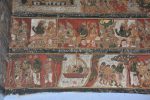
Date: mid-19th century
Description: Top row: King Dasharatha washes Vishvamitra’s feet; Vishvamitra; Vasishtha talk to the king and Sumantra; Vishvamitra asks the king to entrust Rama to him; The king is on the verge of fainting and Sumantra steadies him; Second row: Vasishtha and his
charges are ferried across the river and perform their ablutions.
Location: Tamil Nadu Palace;Bodinayakkanur
Positioning: Lakshmi Vilasam
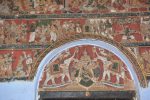
Date: mid-19th century
Description: Top row: King Dasharatha entrusts Rama and Lakshmana to the sage Vishvamitra and, along with his three queens and Vasishtha, sees them off at Ayodhya’s gate; They proceed to the forest where they spend their first night under the watchful eye of the sage; Second row: Rama liberates Ahalya from her curse. In the arch above the door: Gaja Lakshmi.
Location: Tamil Nadu Palace;Bodinayakkanur
Positioning: Lakshmi Vilasam
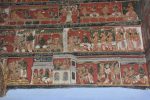
Date: mid-19th century
Description: Top row: The queens and the four toddlers; The princes are trained in various disciplines by Vasishtha; Second row: Vishvamitra and his charges visit the Anga (?) hermitage and then proceed further, beyond a river, to yet another hermitage; Here they meet three rishis; Third row: The arrival of Vishvamitra and his charges in Mithila; Sita sees Rama from her window; King Janaka, his guru Shatananda, and his minister welcome the sage; Vishvamitra and the princes in conversation with Janaka and his courtiers.
Location: Tamil Nadu Palace;Bodinayakkanur
Positioning: Lakshmi Vilasam
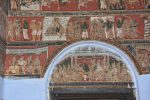
Date: mid-19th century
Description: Top row: Vishvamitra and his charges arrive at the Ganges and are ferried across it; They enter a forest; Second row: King Janaka, his chaplain, Shatananda, and his ministers talk to Vishvamitra and the princes; In the arch above the door: Vishvamitra and the youths before Janaka’s assembled court.
Location: Tamil Nadu Palace;Bodinayakkanur
Positioning: Lakshmi Vilasam
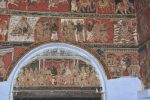
Date: mid-19th century
Description: Top row: Vishvamitra and his charges arrive at the Ganges and are ferried across it; They enter a forest; Vishvamitra encourages Rama to kill Tataka; Second row: On the right: Janaka, Shatananda,Vishvamitra; Rama and Lakshmana. In the arch above the door, Vishvamitra and the princes before Janaka’s assembled court.
Location: Tamil Nadu Palace;Bodinayakkanur
Positioning: Lakshmi Vilasam
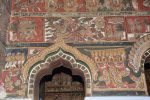
Date: mid-19th century
Description: Top row: Vishvamitra encourages Rama to kill Tataka; Her liberated soul ascends to heaven in a chariot; Vishvamitra, Indra and other gods praise the princes; The gandharvas scatter a rain of flower petals upon Rama and Lakshmana; The sage bestows the magical weapons upon Rama; Second row (left): Four servants; (right) Nine bearers carry Shiva’s bow.
Location: Tamil Nadu Palace;Bodinayakkanur
Positioning: Lakshmi Vilasam
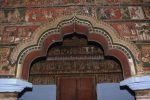
Date: mid-19th century
Description: Top row: Vasishtha trains the princes in swordsmanship and archery; Second row: Indra and other gods, the gandharvas and Vishvamitra praise Rama for killing Tataka; Vishvamitra bestows the magical weapons upon Rama and teaches him how to use them; In the background, behind the lobed arch, the door to the darbar hall and murals depicting the wedding of the four princes.
Location: Tamil Nadu Palace;Bodinayakkanur
Positioning: Lakshmi Vilasam
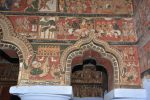
Date: mid-19th century
Description: Top row: Vishvamitra instructs Rama on the use of the magical weapons; The trio visits an ashram and after meeting with the rishis, Rama and Lakshmana are requested to protect their yajna; Second row (left): Bearers carry Shiva’s bow; Two ushers (right).
Location: Tamil Nadu Palace;Bodinayakkanur
Positioning: Lakshmi Vilasam
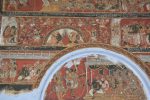
Date: mid-19th century
Description: Top row: After performing their ablutions, Rama and Lakshmana protect the rishis’ yajna; They kill Subahu while Maricha, hit by an arrow, is propelled into the sea; The grateful rishis bless them; Second row: Rama and Lakshmana stand before Vishvamitra, Janaka and his courtiers; Shiva’s bow is at Rama’s feet; In the arch above the door: Rama breaks the bow into three pieces before the assembled court to the amazement and dismay of Sita’s suitors.
Location: Tamil Nadu Palace;Bodinayakkanur
Positioning: Lakshmi Vilasam
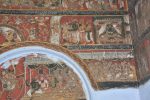
Date: mid-19th century
Description: Top row: Rama and Lakshmana fight against Subahu and Maricha; Subahu is killed while Maricha hit by an arrow is propelled into the sea; The rishis bless the princes; They rest in an ashram under the watchful eye of Vishvamitra; Second row: Rama breaks the bow into three pieces before Janaka’s assembled court; The princes invited at Sita’s svayamvara (a ceremony in which the bride choses her husband) are dismayed at Rama’s victory.
Location: Tamil Nadu Palace;Bodinayakkanur
Positioning: Lakshmi Vilasam
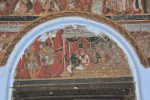
Date: mid-19th century
Description: Rama breaks Shiva’s bow before Vishvamitra, Shatananda, Janaka and the princes invited to participate in the contest to win Sita’s hand.
Location: Tamil Nadu Palace;Bodinayakkanur
Positioning: Lakshmi Vilasam
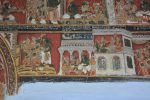
Date: mid-19th century
Description: Vishvamitra and the princes reach Mithila and are ushered into the palace; Sita sees Rama from her window.
Location: Tamil Nadu Palace;Bodinayakkanur
Positioning: Lakshmi Vilasam
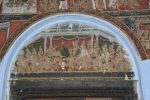
Date: mid-19th century
Description: In the arch above the door: Vishvamitra, Rama and Lakshmana are received by King Janaka and his courtiers.
Location: Tamil Nadu Palace;Bodinayakkanur
Positioning: Lakshmi Vilasam
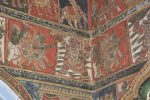
Date: mid-19th century
Description: The rakshasi Tataka, armed with rocks and boulders confronts Rama and Lakshmana; Vishvamitra looks away.
Location: Tamil Nadu Palace;Bodinayakkanur
Positioning: Lakshmi Vilasam
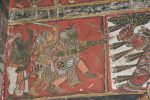
Date: mid-19th century
Description: Vishvamitra orders Rama and Lakshmana to kill the rakshasi Tataka.
Location: Tamil Nadu Palace;Bodinayakkanur
Positioning: Lakshmi Vilasam
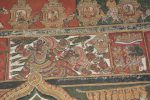
Date: mid-19th century
Description: Tataka’s death; A chariot conveys her liberated soul to heaven; Vishvamitra praises the princes; Indra, the gods, and the gandharvas celebrate their victory.
Location: Tamila Nadu Palace;Bodinayakkanur
Positioning: Lakshmi Vilasam
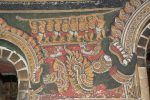
Date: mid-19th century
Description: Nine bearers carry Shiva’s bow into King Janaka’s assembly hall.
Location: Tamil Nadu Palaces;Bodinayakkanur
Positioning: Lakshmi Vilasam
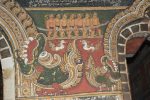
Date: mid-19th century
Description: Seven bearers carry Shiva’s bow into King Janaka’s assembly hall.
Location: Tamil Nadu Palace;Bodinayakkanur
Positioning: Lakshmi Vilasam
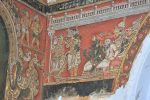
Date: mid-19th century
Description: Rama and Lakshmana, Shiva’s bow at their feet, stand before Vishvamitra, Shatananda, King Janaka, and his minister.
Location: Tamil Nadu Palace;Bodinayakkanur
Positioning: Lakshmi Vilasam
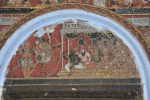
Date: mid-19th century
Description: Under the gaze of Lakshmana, Vishvamitra, Shatananda, King Janaka and the other princes invited to Sita’s svayamvara (ceremony in which the bride choses her husband), Rama breaks Shiva’s bow into three pieces.
Location: Tamil Nadu Palace;Bodinayakkanur
Positioning: Lakshmi Vilasam
« Previous 1 2 3 4 5 … 11 Next »